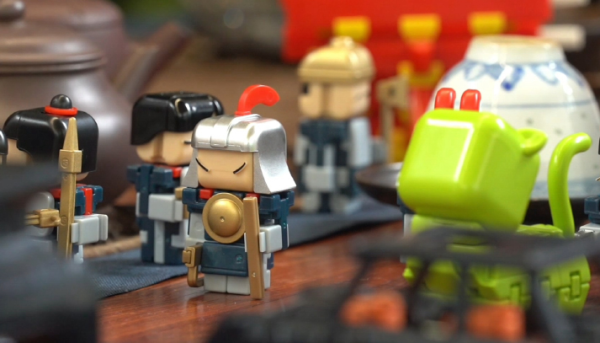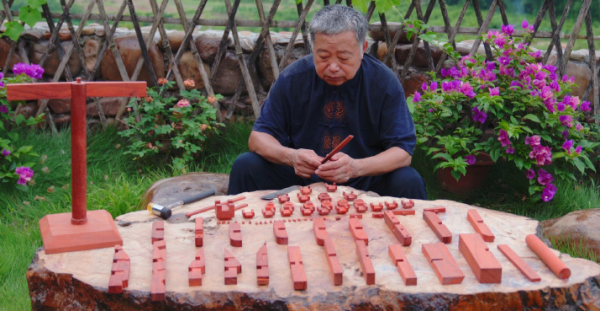The Forbidden City, constructed over 600 years ago, served as the imperial palace of the Ming (1368-1644) and Qing (1644-1911) dynasties. Its wooden-framed buildings, erected without nails or glue, have existed for hundreds of years and weathered several earthquakes. The secret lies in sunmao, or the mortise and tenon technique, which is a concave-convex joint used to connect two sections of wood commonly applied in ancient Chinese architecture, furniture and other wooden instruments. The convex part is called the tenon (sun), and the concave part is called the mortise (mao). Mortise and tenon together create the dovetailed connection.
To revive mortise and tenon, 20-something Wang Ran has integrated the traditional building technique into toy blocks. In 2020, he became a co-founder of the mortise and tenon building block company Qiaohe based in Beijing. Its products range from ancient soldier figurines to toy tanks. The material used today is plastic, but the ancient method has been maintained.
According to Wang, he started learning the mortise and tenon technique from his mentor Liu Yansong, an inheritor of the technique, an intangible cultural heritage item, in 2019. Aside from designing toy blocks, he would also give lectures at schools and colleges in Beijing to promote the culture.
“Mortise and tenon deliver a sense of traditional culture. Through toy blocks, the technique transcends time and race and passes on knowledge to later generations,” Wang told Beijing Review.

The mortise and tenon products of Qiaohe Company, from imperial soldiers to toy tanks (YIN KANG)
A modern makeover
Mortise and tenon got their name in the Song Dynasty (960-1279). During that era, the construction method was in the earliest stages and people were still unable to produce accurately convex parts. During the Song, people mainly used simple mortises that could be spliced to ensure a stable connection between articles, Wang said.
According to him, ancient architectural practices were quite precise. The details were clarified in books with illustrations to showcase different ways of construction. Every single detail, including how many craftsmen it requires, how long it will take, and what kind of craftsmanship it takes to create a small part, was specified. One notable work in the field is Yingzao Fashi, or Building Standards, a Chinese technical manual on buildings compiled in the Song. It features many illustrations regulating the standards of materials and building techniques. In the Ming and Qing, the method matured, with an increasing application in furniture.
Recent years have seen the revival of traditional Chinese techniques, with masters of the mortise and tenon method appearing once again. As modern Chinese youth seek to entertain themselves in more diverse ways, the art toys of domestic brands like Pop Mart, Danish toy company Lego’s products, and a range of blind boxes, brand packages containing unknown products, have become popular. Many homegrown toy brands, such as building block brand Keeppley, have introduced Chinese-style products like ancient Chinese building models. It seems mortise and tenon toy blocks, too, bear some great market potential.
According to a report released by China’s e-commerce company JD.com in May, China’s toy market was worth around 77.9 billion yuan ($11.5 billion) in 2020, of which 16.2 percent were toy blocks.
To tap into surging market demand, Wang has merged his innovative ideas with ancient craftsmanship. One of Qiaohe’s best-selling products is a series of toy soldiers produced in collaboration with the National Museum of China. The series include six toys of different appearances, each representing a soldier of an imperial Chinese dynasty. Each set usually consists of a dozen pieces. According to Wang, toy blocks with fewer pieces are easy for children to play with.
Many consumers visiting Qiaohe’s online store are parents, and the majority comment that their children are interested in the toys. But people in their twenties, too, are buying the products—just for fun.
Many people refer to mortise and tenon toy blocks as “China’s Lego,” but Wang thinks they are two different concepts. According to him, Western philosophy focuses on piling up the pieces. The new parts relate to the original ones, which gradually grow bigger and bigger; mortise and tenon building blocks are within a fixed frame, like a door, limiting their expansion.
Wang hopes the toy blocks will eventually become a prime example of Chinese art toys. “I want to use young people’s ideas and innovations to inject new vitality into mortise and tenon culture,” he said.

Wang Dewen, or Grandpa Amu, produces mortise and tenon works at his home in Guangxi Zhuang Autonomous Region, on July 22, 2021 (COURTESY PHOTO)
Master among masses
Some of the method’s masters have even built up an international reputation. Sixty-something master carpenter Wang Dewen, commonly known as Grandpa Amu, is another expert in the field of mortise and tenon. Dubbed the “21st-Century Lu Ban,” a Chinese handcraft master who lived some 2,500 years ago, he has brought the skills back to life through diverse appliances and toys. His son, Wang Baocheng, started shooting videos of his dad at work in 2018. The content captures his skills as well as the beautiful countryside scenery, gaining over 1.4 million followers on YouTube.
Grandpa Amu has been studying the mortise and tenon technique since he was 13. In 2017, he moved to Guangxi Zhuang Autonomous Region together with his son’s family. Since then, he has crafted many wooden toys for his grandson, including a wooden Peppa Pig, an apple-shaped lock and a mini wooden robot that can walk. He is particularly skillful in making the Luban Stool, a foldable stool made from one piece of wood.
When it comes to wooden handmade furniture, Grandpa Amu insists on carrying forward the longstanding technique and using traditional tools. He is forever honing his craft.
His skills impressed many overseas viewers. “Utterly amazing to watch how Grandpa Amu built this bridge. Doing it all with hand tools and zero power equipment or glue or nails. This little bridge will be around for all in this man’s family to cherish and see the beautiful job their Grandpa Amu has done. After watching this, I can see why it has so many views. Hats off to you, Grandpa Amu, and I hope your son and others in your family will carry forward what they have learned from you,” a YouTube user surnamed Norris commented below one of the videos.
But Grandpa Amu told Xinhua News Agency it is the traditional technique, not him, that has become an online celebrity. “I hope to pass on the craftsmanship and better present Chinese culture,” he said.
Media Contact
Company Name: Center for the Americas, China International Communications Group
Contact Person: Li Xiaoyang
Email: Send Email
Country: China
Website: https://youtu.be/rWcJ1ef9tXo













